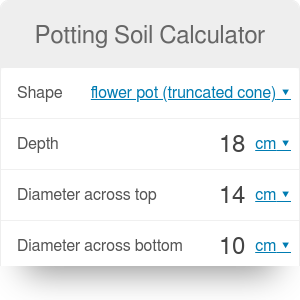

Doing so will leave you with the amount needed in cubic feet for whatever soil application you need, from pots to raised beds to new lawns. To summarise, the basic concept for finding the amount of soil required per square foot is to multiply the square foot area by the depth measurement converted to feet. Therefore, you would need approximately 0.5 ft 3 to cover each square foot based on the required soil depth of 6-inches. The soil area for this example is a square foot, based on a profile that is one foot in both length and width.īecause we’re working on the basis of square feet, we’ll need to convert the soil depth (currently in inches) to feet, which you can do by dividing the inch dimension by 12 (6″ / 12 = 0.5 feet for this example). Let’s work through an example of a 6-inch deep layer of soil. The calculation to work out the quantity or volume required is as follows: It’s probably stating the obvious, but you’ll require more soil per square foot for a 4-inch deep than a 3-inch deep layer. It’s relatively easy to calculate how much soil you require per square foot, although you will need to know how deep you want your soil layer to be. How Much Soil Do I Need for a Raised Bed? How Much Soil Do I Need per Square Foot?.How Much Soil Do I Need per Square Foot?.
#Soil volume calculator how to
Let’s look at some real-life example calculations to show you step-by-step how to work out how much soil you need: These equations remain the same whether you’re working with metric units like meters or imperial units like feet or yards.

We’ve provided sample densities for various soil types in the calculator above, but for the most accurate calculation, we’d recommend using the density value supplied by the manufacturer or supplier of your soil. Weight Required = Area Volume x Material Density You can select the relevant units (in both metric and imperial) for each measurement using the ‘Unit’ dropdowns. The calculator will automatically reformat depending on the soil profile type chosen, meaning only the relevant dimensions will be shown. You’ll also need to enter the planned ‘Soil Depth’ value in the relevant input box. ĭepending on the soil profile chosen, you’ll need to enter various dimensions, for example, ‘Length’, ‘Width’, and ‘Diameter’.We would recommend using a custom density value, however, if you have a specific value available from the supplier of a type of soil you’re planning to use.
#Soil volume calculator update
You can update the ‘Density’ figure if needed, although this is based on industry guidance for each material. The ‘Density’ box will automatically be populated based on the type of soil you choose. You can also choose ‘Custom Soil’ if there’s a specific type of soil that you’d prefer to use.

You can find out more about the various types of soil later in the article, but if in doubt, we’d recommend sticking with the ‘General Soil’ option.


 0 kommentar(er)
0 kommentar(er)
